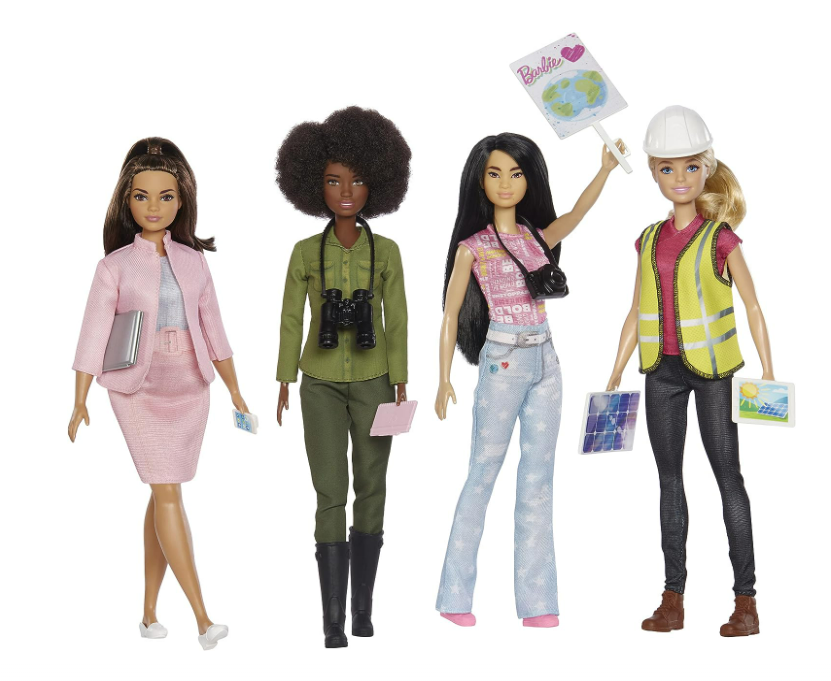Who wants to be a Chief Sustainability Officer?

My husband asked me if I planned to take our girls to see the Barbie movie. My kids have never had Barbie fever, so honestly, I don’t even think they’re aware of the movie. And yet, I’m curious. Barbie and her manifestations are a symbol of how our society thinks about women, femininity, and even leadership.
Full disclosure, our family didn’t own a single Barbie until late last year, when Mattel debuted a new set of four environmentally-themed dolls. Given my background in sustainability, I was intrigued. What is Mattel up to?
In Barbie’s long life, she has been many things, but I think it’s not a reach to say that most of us tend to think of her as an unrealistically proportioned woman whose feet seem like they might cramp up at any moment. Yet, she’s transformed into an astronaut, a dentist, a fashion designer, a floral designer, a rapper, and more.
Well, did you know that now, she can even be a Chief Sustainability Officer (CSO)?
CSO Barbie is one of a set of four Eco-Leadership Team dolls that Mattel released last last year: “Do you like collaborating and working with a team to help the environment? You Can Be a Chief Sustainability Officer!” Says the recycled cardboard packaging.
Yes, you can! 👏 It’s a hugely positive aspiration, and one is incredible to see, not just because these skills are in-demand from employers, but because they’re highlighting career fields where women can come into their own power.
In my role at Leaders’ Quest I frequently work with CSOs and their CEOs, and so Eco-Leadership Barbie and the Barbie movie have me thinking about the responsibilities of quickly evolving roles like the CSO, and those of the other dolls that Mattel has marketed recently: a conservation scientist with binoculars and a notebook; a renewable energy engineer with hard hat, safety vest, solar panel, and tablet; and an environmental advocate with camera and sign.
Whichever you are, or aspire to be, these valuable roles are full of paradoxes–just like Barbie!
Taking the CSO as an example, the common challenges I see in my work with Leaders’ Quest include:
Five paradoxes of the CSO
- Making the business case when success isn’t always measurable in conventional terms. This is a common challenge for CSOs who are looking long-term and holistically, but being measured on quarterly or annual results.
- Balancing great stories with hard work. I often work with CSOs who are able to garner support for highly visible activity that is good for PR and for the brand, but not for the hard work that happens in the background that makes an incremental but meaningful difference.
- Aligning the priorities of shareholders and consumers. While this isn’t a direct responsibility of the CSO, they keenly feel the pressure that the CEO is getting from the Board, shareholders, and consumers.
- Running too fast or too slow. It’s a balancing act for the CSO to make enough change that stakeholders see and value, but not to go so fast that they lose buy-in from key figures like the Board and CEO.
- Beating the drum, but not too loudly. Because of the economic importance of corporate environmental and social governance (ESG), the agenda has become politicized and risks distracting people from the mission of the CSO.
What strikes me about all of these paradoxes is that they are not about whether a business can become sustainable or regenerative. They are about mindset change:
Are the CEO and Board bought into the benefits of sustainable business and are they prepared to buy-in for a length of time sufficient for a CSO to start making a difference?
Is the leadership team open to new language, new timeframes and new ways of measuring success?
Is the leadership team willing to balance highly visible activity like tree planting, with the hard work of measuring and reducing carbon emissions in the background?
Often, the answer is muddled.
Business leaders understand the rationale, but they’re in what we call the ‘messy middle’ where they’re still figuring out why and how to change. At Leaders’ Quest, this is where our work excels. As one of our recent clients said, our programming offered insights into the ‘inner game of leadership: “It gave me the tools, motivation, and energy to work with nuance within contested spaces in an increasingly polarized world, with far-reaching benefits beyond my professional life.”
We focus on the internal aspects of change. We help leaders make the inner journey where new insights, mindsets, behaviors, and awareness can grow. This brings a whole new dimension to how we direct our energies towards regenerative business leadership. If you want to hear more, please feel free to reach out to me.
And how about Barbie? Can she also evolve?
One of the organizations I worked for in the early aughts aimed to put a woman in the White House. The organization, The White House Project, worked closely with Mattel for several years to get a “Barbie for President” into toy stores. Culture change was just as important as training women to run for political office. When any of our young feminist colleagues asked why we were collaborating with Mattel, our co-founder reminded us, “You can’t be what you can’t see.”
In the copy that Mattel uses to describe the Eco-leadership Team Barbies, they state, “When kids play with Barbie, they imagine everything they can become.”
As she launches her own corporate sustainability career, maybe Barbie offers something meaningful to women and girls after all.


